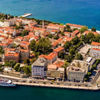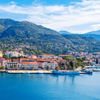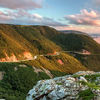
Exquisite heritage: a stroll through Kotor’s old town



Enchanting cultural mix
Nearly hidden in “Europe’s southernmost fjord” lies Kotor, a true gem for its Mediterranean cultural history. With the emerald waters of the Adriatic below, monasteries, fortresses, and palaces cling to the karstic mountains. Palm trees sway in the breeze above the terracotta-coloured tiled roofs. Like the Romans and Byzantines before them, the Venetians played a major role in making trade and culture flourish here. In later years, other rulers added to the charming combination of Orient and Occident that saw Kotor included among UNESCO World Heritage Sites in 1979. Take a stroll and allow yourself to be seduced by the old splendour of this small cosmopolitan city...


A break in the Sun
Kotor’s most important square is Trg od Oružja, Square of the Arms. This is where open-air meetings were held to discuss and resolve all affairs relating to the city — right next to the Venetian arsenal where the weapons were stored. Even today, the heart of the city beats here. Witness the southern joie de vivre over a cappuccino under a colourful parasol. There are certainly no shortage of picturesque restaurants and quirky bars. For those who would like to learn more, we recommend visiting the neighbouring Prince’s Palace, the city watch tower, and the theatre that dates back to Napoleonic times.

A church for the goose herder
The Cathedral of Saint Tryphon stands in the middle of the busy centre and is one of the largest preserved Romanesque churches on the Adriatic coast. Step inside to admire the Byzantine frescoes and icon paintings. The church was completed in 1166 and is dedicated to Saint Tryphon who, legend has it, was only a goose herder, but endowed with supernatural healing powers. He is the patron saint of gardeners and winegrowers, and also of the city of Kotor. But even he was not able to prevent the church from repeatedly suffering serious damage: The cathedral’s original towers were destroyed in an earthquake in 1667.

The view from the castle
Instead, you can now admire Renaissance and Baroque elements, the legacy of various restorers. A breath taking panoramic view of the glittering bay rewards those who climb the 1,350 stone steps to Sveti Ivan’s Fortress. The castle was built between the 9th and 15th centuries and stands at 280 metres above sea level. Your admiration for this architectural achievement will also increase with every metre you climb. The terrain is steep and it takes about 45 minutes to reach the medieval ruin at a relaxed pace.

Climbing for all
The wall of the old fortress is a prime example of the interplay between landscape and architecture: Facing the sea, there is the impressive gate to protect against intruders, while facing the east, the bulwark winds its way along the steep mountain slope. Despite - or possible precisely because of - this protective wall, Kotor has also served as a hideout for pirates. The wall, built between the 14th and 17th centuries, suffered serious damage during an earthquake in 1979. The reconstruction of the over four-kilometre-long and up to 15-metre-wide structure was funded by UNESCO. This is a great place to bring the children as they can storm and conquer it completely non-violently.
Header - Photo by China Span on Alamy
Paragraph 1 - Photo by DariaZu on Gettyimages
Paragraph 1 - Photo by Алексей Облов on Gettyimages
Paragraph 2 - Photo by Karl Allen Lugmayer on Shutterstock
Paragraph 2 - Photo from Mauritiusimages
Paragraph 3 - Photo by Sergii Kolesnyk on Mauritiusimages
Paragraph 4 - Photo by canadastock on Gettyimages
Paragraph 5 - Photo by Evelyn Paris








